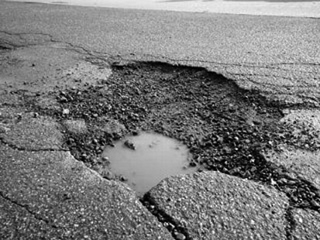
Ann Arbor and Washtenaw County Get Second Largest Distributions of $60.9M in Supplemental Road Money
MICHIGAN’S GOVERNOR HAS been pushing Lansing lawmakers to craft a long-term solution to address the state’s crumbling roads. He has estimated that Michigan must increase road funding by more than $1 billion a year in order to significantly improve the state’s roadways. After months of discussions, legislators in both chambers agreed to fund $100 million in supplemental road money. Counties and cities across Michigan are expected to use the funds to patch up potholes and clear away ice and snow from roads. The Washtenaw County Road Commission and cities within the county received a total of $1,713,550.51, the second highest amount allocated.

The Michigan Department of Transportation (MDOT) received approximately $39 million of the $100 million allocated by lawmakers in the first week of April. Ann Arbor is set to receive $461,171.49 to use to fund additional road maintenance. Ann Arbor taxpayers already pay an additional Street Repair millage which generates between $8-$11 million per year. According to a list of allocations released by the state, Ypsilanti was allocated $68,251.08, Chelsea, Dexter and Milan each received between $15,000 and $25,000 and Saline was granted $33,639.79.
Detroit received the largest single slice of the pie at $3,298,154.38. In 2011, the Michigan Infrastructure and Transportation Association (MITA) unveiled a list of the state’s worst roads, naming Detroit as the worst municipality with 523 lane miles in poor condition. Detroit was followed by Ann Arbor (187), Grand Rapids (178), Flint (148) and Lansing (136). The group also announced that the five top counties with the worst roads were Wayne (1,617), Oakland (1,279), Genesee (1,093), Washtenaw (989) and Calhoun (665).
Each of those five counties received the following allocations from the $100 million pot of the money for road repair:
Wayne County: $ 3,740,802.50
Oakland County: $3,861,456.65
Genesee County: $1,345,161.25
Washtenaw: $1,091,502.29
Calhoun County: $517,020.90
Of the cities in the state with the worst roads, the allocation of funding was as follows:
Detroit: $3,298,154.38
Ann Arbor: $461,171.49
Grand Rapids: $836,577.04
Flint: $530,457.46
Lansing: $516,438.31
Amounts awarded reveal that Republican-leaning counties received more funding than Democratic-leaning counties. Oakland County has about 30 percent more lane miles of roads in poor condition than Democratic-leaning Washtenaw County. Yet, Oakland County was awarded more than triple the funding that Washtenaw County was awarded.
“We’re not going to fix the problems with $100 million, $30 million, $50 million, whatever,” he said. “We just are going to try to get to the worst of the problems. But it’s going to be hard to ascertain where those are,” said Senate Majority Leader Randy Richardville, R-Monroe.
Ann Arbor mayoral candidate Christopher Taylor who has never voted against City Administrators’ proposals to repair and replace single-digit lane miles of roads in Ann Arbor, posted this to his campaign Facebook page: “Ann Arbor gets $460K+ for additional road maintenance. This is entirely insufficient….We need more and Lansing needs to hear it.”
There have been complaints from Michigan Democrats that Republicans are playing politics with the infrastructure. The 2013 road repair list, approved by the Republican-controlled leadership in the House and Senate, along with the Michigan Department of Transportation, had 103 projects across the state. Of those, 84 of the projects were submitted by legislators, and only two of the projects went to Democrats.
The 2014 list submitted by legislators for the new round of road projects was huge, said Ari Adler, spokesman for House Speaker Jase Bolger, R-Marshall. MDOT estimated that it included about $800 million worth of projects each from the House and Senate and another $800 million worth of projects from MDOT. Those requests were whittled down to a total $115 million worth of roadwork. Only 46 of the state’s 83 counties got projects, and the population rich — but mostly Democratic — Wayne County got only four projects on the list, while the Upper Peninsula got seven.
Likewise, from the $100 million that the Legislature approved to deal with the effects of the brutal winter, Oakland County received more than Wayne County despite that fact that Wayne County has one-third more lane miles of roads in poor condition. Republican-leaning Grand Rapids, with nine fewer miles of roads rated in poor condition, received $400,000 more than Ann Arbor.
Of the 50 states, Michigan spends the least per capita on its roads and bridges, according to 2010 U.S. Census Bureau data. Michigan spends $174 per person annually on transportation. Illinois and Ohio each spend $235. Minnesota spends $315.
Each year, the poor condition of Michigan’s roads costs state residents $7.7 billion in additional vehicle operating costs, wasted fuel, lost time and traffic accidents, according to a January report by TRIP, a national transportation research group. That adds up to $1,600 for the average Detroit-area driver each year, $1,032 for the average Lansing-area driver and $1,027 for each Grand Rapids-area motorist, TRIP found.
The average Michigan motorist spends $357 a year on blown tires, bent rims and other repairs due to bad roads, TRIP estimated.
Inferior roads come with another cost that can’t be measured in dollars: If Michigan significantly increased its investment in roadway safety features, such as adding rumble strips and turn lanes, it could avoid nearly 100 traffic fatalities each year, TRIP estimated.
